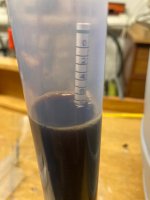Davedrinksbeer
Well-Known Member
- Joined
- May 12, 2017
- Messages
- 118
- Reaction score
- 82
Ok, still learning the trade. Thanks for the answers.
Just one more, would aerating the wort with pure oxygen have helped with the FG at all? (Probably not if the sugar isn't fermentable)
i bought a wine degasser wand for $20 that’s hooks into a power drill. Works great



